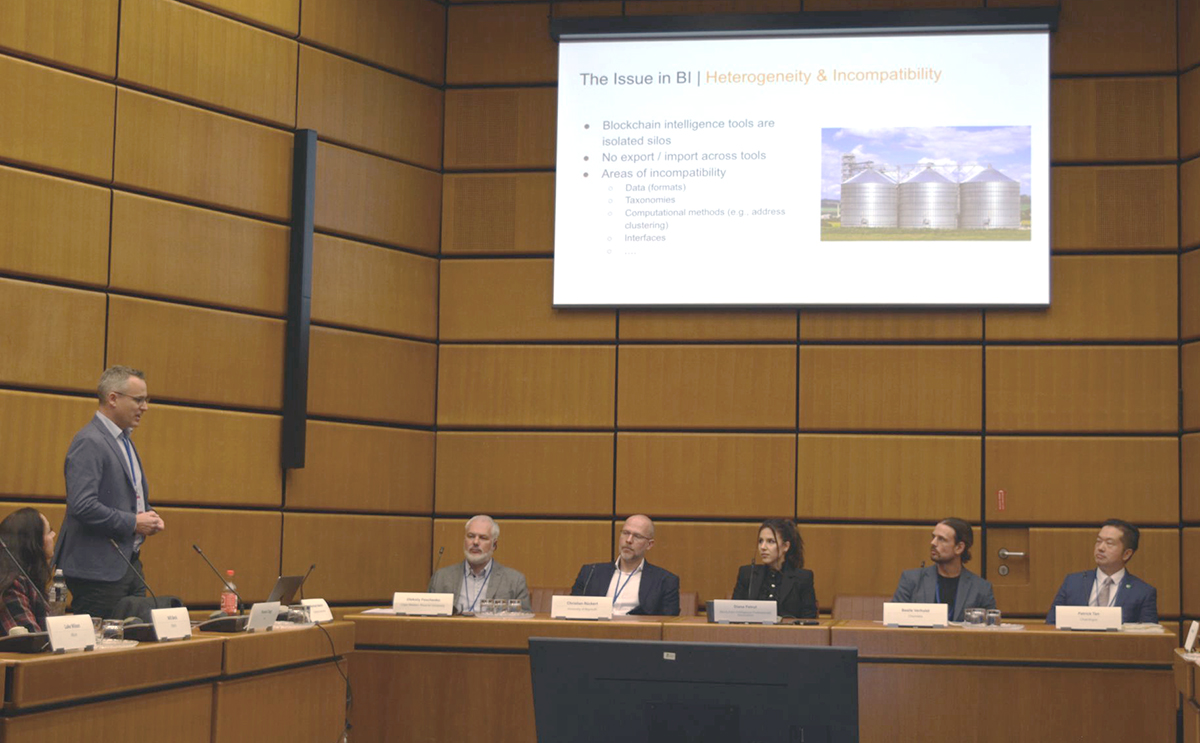Developing blockchain intelligence standards and interoperability: a critical need to fight financial crime in the digital age

A breakout session at the 9th Global Conference on Criminal Finances and Cryptoassets focused on blockchain intelligence standards and interoperability – an issue that is becoming ever more critical for all who seek to prevent and combat the illicit use of virtual assets for financial crime.
Breakout leader Bernhard Haslhofer of the Complexity Science Hub Vienna explains the challenge below, and why the breakout represents a promising step towards the co-development of open standards in this domain.
The absence of standardisation and interoperability among blockchain intelligence tools has emerged as a critical challenge for all stakeholders working on preventing and countering financial crime.
Incompatibilities manifest across multiple dimensions: data formats vary between platforms, identical concepts are described using different terminologies, computational methods such as address clustering follow divergent approaches, and user interfaces lack consistency.
Consequently, problems include:
- Investigators work with isolated tool ecosystems with no systematic mechanisms for connecting investigations across platforms. This hinders inter-agency and cross-border cooperation.
- Prosecutors face problems demonstrating the reliability, admissibility and validity of blockchain evidence in court, in the absence of court-proof forensic procedures and standardised methods (in contrast to DNA analysis, for example).
- Judges in court proceedings involving blockchain intelligence currently rely on case-by-case testimonies from tool providers or expert witnesses. This creates resource-intensive judicial processes and lacks consistent interpretation across cases.
- Regulators and supervisors for anti-money laundering and counter financing of terrorism (AML/CFT) use inconsistent blockchain intelligence methodologies and typologies to monitor for suspicious transaction patterns and conduct risk profiling.
- Training and certification are also at stake. The field lacks independent qualification standards, allowing unqualified practitioners to operate in the field and undermining professional credibility across the domain.
This situation reflects a typical pattern in emerging technology domains. Historical parallels exist across industries. For example, electrical systems evolved from incompatible regional standards to interoperable networks through adapter technology. Word processing software transitioned from proprietary formats to systems supporting cross-platform document exchange, without capitalising on the strengths of individual tools.
As blockchain intelligence transitions from an emerging field to an established professional domain, adopting similar standardisation approaches becomes necessary to ensure long-term viability and effectiveness.
A promising step towards collaboration
At the 2025 9th Global Conference on Criminal Finances and Cryptoassets organised by Europol, the Basel Institute on Governance and UNODC, we convened a workshop on creating harmonised standards for blockchain intelligence. The session assembled expertise from multiple domains: existing standardisation initiatives by INTERPOL and the Global Coalition to Fight Financial Crime, legal scholarship and practice, and operational perspectives from both analytics providers and cryptocurrency exchanges.
In addition to participants from legal and academic backgrounds, we had strong industry representation including blockchain analytics firms and cryptoasset exchanges. This ensured technical feasibility considerations informed the discussion.
The workshop addressed four critical components:
- Defining the technical scope by identifying specific components and processes requiring standardisation across blockchain intelligence tools and workflows.
- Outlining the legal and regulatory framework, including jurisdictional considerations, data handling protocols and compliance requirements.
- Mapping stakeholders whose participation is essential for standard adoption and implementation.
- Developing a concrete implementation pathway from initial agreement through pilot implementation to deployed, operational and open standards.
Technical scope
The discussion identified interoperability challenges across multiple technical layers. Immediate opportunities include:
- standardised data formats for attribution tags enabling third-party dataset integration;
- unified terminologies to eliminate semantic conflicts across platforms; and
- standardised investigation formats allowing transaction graph sharing without exposing proprietary attribution data.
These standards would provide direct operational benefits while respecting competitive boundaries between tool providers. For criminal prosecutions or asset recovery proceedings, they would also support the documentation of attribution tag provenance with a clear chain of custody and evidence classification.
Address clustering on UTXO chains such as Bitcoin presents greater complexity. Applied computational methods such as address clustering must provide transparent justification for grouping addresses into single entities. Yet experts noted significant variation in clustering results across tools and limited external verification capabilities. Providers meanwhile emphasised that computational methods constitute intellectual property, though accessible for regulatory scrutiny.
Participants agreed that initial standardisation efforts should prioritise readily implementable solutions, with any framework accounting for economic incentives that protect proprietary intelligence from competitors.
What would standards look like?
Open standards for blockchain intelligence would be technical in nature but practical in impact. Examples of successful open standards in other domains include:
- IETF RFC standards describing internet technologies, protocols, and procedures
- W3C Web Standards ensuring a consistent and harmonious digitally connected world. They are implemented in browsers, blogs, search engines, and other software that power our experience on the web.
- STIX and TAXII are industry standards for sharing cyber threat intelligence.
Stakeholder participation and incentives
The successful development and implementation of standards require engagement from at least three stakeholder groups:
- Blockchain intelligence providers must contribute to the standardisation process and implement them within their platforms.
- User communities, including law enforcement agencies, financial regulators, cryptocurrency exchanges and financial institutions, must articulate operational needs and validation criteria.
- Technical experts provide methodological guidance to ensure standards are robust, implementable, and account for current capabilities as well as future scalability.
Incentive structures differ across stakeholders. Tool providers benefit from meeting expressed user requirements. Establishing technically grounded standards through bottom-up consensus would also pre-empt potentially impractical top-down regulatory mandates.
Users gain operational autonomy and reduced vendor lock-in. This enables investigative continuity across platforms and organisational flexibility in tool selection, as well as enhanced reliability and sharing of blockchain intelligence data.
Next steps and learn more
Participants agreed that continued discussion must translate into concrete action, prioritising readily implementable solutions while considering incentive structures across all stakeholder groups. Follow-up steps will be announced in due course. Meanwhile:
- See the joint press release from the 9th Global Conference on Criminal Finances and Cryptoassets, including links to recordings from public sessions.
- Read a Q&A with Vincent Danjean, Head of INTERPOL’s Cyberspace and New Technologies Laboratory, on efforts to enhance the quality of blockchain intelligence.
- Learn more about the concept and use of blockchain intelligence and why professional standards are needed.
- Need the basics? Check out the Basel Institute's introductory courses on blockchain: crypto investigation and AML compliance.



